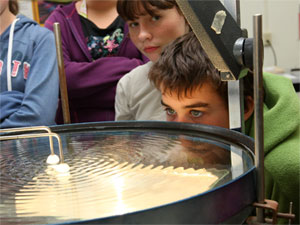| ||
| ||
|
Those two words don't often sit together, but they do at Dalhousie, where Physics Fun and Discovery Days were held on June 11 and 12.
Approximately 60 Grade Six students from Tantallon Elementary School swarmed the lobby of the Sir James Dunn building on Wednesday morning. Students took part in three sessions: the Holo-Tent, the Liquid Nitrogen Show and the Planetarium.
Grad students with the Department of Physics and Atmospheric Science gave talks on nitrogen, space and lasers. Research associate Stephen Payne delivered a mini lecture on light and holograms to a rapt audience of 12 year olds using a water ripple machine and a helium-neon gas discharge laser.
Holograms are made using a laser beam and shining it on a concave mirror. When the reflected beam arrives at the emulsion, a material similiar to photographic paper, a three-dimensional picture can be made of an object hiding behind the emulsion.
"And once developed, the emulsion produces a hologram of the object hiding behind the film," says Mr. Payne.
Students were then led into the large black Holo Tent to make their own holograms in the dark room with lasers and development solutions.
"The whole process takes about 11 minutes," says Peter Klages, a grad student doing research in digital holography.
Kids waiting their turn into the dark room learned the history of lasers from posters placed on the tent.
"It's so very interesting," remarked Zack Cameron, a Grade 6 student." I just like learning how these college geniuses can make holograms and learning how things work."
The Department of Physics and Atmospheric Science is hoping to make this an annual event.



